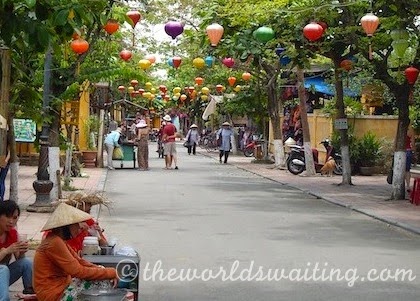
What to see in Hoi An Old Town
Stepping on a dead rat may not have been the best start to our walking tour of Hoi An but it did mean it could only get better. Walking is really the only way to explore Hoi An, since much of it is pedestrianised during the day, making for some very pleasant strolling (expired rats aside).
The history of Hoi An
Hoi An dates back to the first century but the town developed significantly between the 15th and 19th century when Hoi An was the main trading centre in central Vietnam. The local architecture blends many influences and ideas. During Vietnam’s French rule trade moved to Da Nang and Hoi An was largely forgotten about. This is probably what has left it so beautifully intact that in 1999 UNESCO declared the old town a World Heritage Site, on account of it’s being a remarkably well preserved and unique opportunity to step into history.

Phuc Kien Assembly Hall
We started our morning at the Phuc Kien Assembly Hall (don’t say that too quickly!) Built in 1690, Phuc Kien functions as both a traditional assembly hall for the Fujian Chinese community and a temple to the goddess Thien Hau, who protects sailors. Phuc Kien’s bright courtyard leads to the traditional hall and then the ornate altar, at which the goddess of fertility and 12 midwives stand. Childless couples come here to pray for children. Many other Fujian deities and symbols also feature. The complex provides an intricate and beautiful display of the beliefs of some of Hoi An’s locals.

Hoi An Craft Workshop
At Hoi An Craft Workshop we saw local women creating what I can only rather lamely explain as ‘pictures’ by completing hugely detailed silk embroidery. Working from paintings or photos they embroider images onto fabric. Apparently many VIPs have commissioned them to create portraits. At the workshop we also saw silkworms being kept, fed and ultimately their silk being harvested, spun and made into thread.

Tan Ky Traditional House
Our next stop was Tan Ky House, which is a wonderfully preserved traditional merchant’s house by the river, which seven generations of the same family have been careful to preserve. The house showcases Vietnamese, Chinese and Japanese design elements in a tribute to the period when Hoi An was occupied by these three communities. Decorative carvings provide intricate detailing to the interior and a rather shocking indicator on a wall near the back of the property shows the flood levels of recent years, which have been almost 2 metres high and prompted the requirement of a trapdoor in the ceiling for the quick evacuation of merchandise to the first floor.
Museum of History and Culture
After visiting the Quan Com Temple we popped into the Museum of History and Culture, which is just behind the temple. The museum contains artefacts dating a long way back into Hoi An’s history, even to the Champa period. There are also lots of historic photos showing how little the streets of Hoi An have been developed, which are wonderful to see.
Hoi An’s Japanese Covered Bridge
Built in the 17th century by Japanese craftsmen to facilitate trading, the Japanese Covered Bridge has become the living icon of Hoi An. Using it to cross the river is like stepping into a moment of history. While you can see the water beneath you if you peer through the floorboards the structure is very solid. Statues of monkey gods guard one entrance and dog gods the other. The bridge is the only known covered bridge to contain a Buddhist Temple, apparently to pray for the soul of a legendary earthquake-creating monster that was killed when the bridge was built.

Old Town streets
Between stops we made our way from street to street in the old town and found the streets charming. The walls were mostly a warm, faded yellow, balconies dripped with bright bougainvillea and there was an aura of calm (during the pedestrianised hours anyway). While walking through Hoi An we saw local craftspeople working in their workshops and gathering together to be social. There are many souvenir shops selling lanterns, clothing and souvenirs. Hoi An is also well known for it’s highly skilled tailors that can whip up beautiful outfits in only a few days. If you have a few days it is definitely worth getting measured up!

One thing that caught our eye was a large group of men sorting things in buckets. On closer inspection, it turned out they were picking through birds’ nests, a local delicacy. Vendors selling souvenirs and tailors offering bespoke outfits would call out as we walked by but were easily deterred with a friendly smile and “No, thank you”, which was a far cry from some of the physical grabbing and other persistent sales tactics we experienced elsewhere in Vietnam. Hoi An is largely a tourist destination these days, but it is still a unique place that has largely been well-preserved and enables visitors to experience historical Vietnam. Walking around the old town provides the opportunity to take it slowly and take in all the detail that you might not notice from a vehicle, such as the traditional eye carved onto the front of buildings to protect against bad spirits.
Visitors need to buy tickets to enter the points of interest in Hoi An. The one ticket you purchase is for entrance to five places. Each time you enter one a rectangular tab is cut off your ticket. However, the tickets are not required simply to stroll in the old town. One ‘snip’ is required to visit the Buddhist Temple on the Japanese Covered Bridge, but not simply to walk across the bridge.
Have you ever been somewhere that felt like time had stood still? Please share your experiences in the comments below.




One Comment
halong bay tours
great post. helpful infomation
thanks.